AFRICA
Laetoli, Tanzania. 3.66 million years (Ma).
- Site G, found in 1978: 70 footprints made by three Australopithecus afarensis. Along with footprints were hominin and animal remains and Acheulean objects. The footprints are normally buried to protect them against the elements.
- Site S (150 m away from Site G), found in 2015: 14 footprints made by two Australopithecus afarensis walking in the same time frame, in the same direction and at a similar moderate speed as the other three. One of them (hominin S1) had an average stature between 161-168 cm.
Ileret, Kenya. 1.5 Ma. They are 97 footprints left by at least 20 Homo erectus individuals, who had a modern foot and stride: a mid-foot arch, straight big toe and heel-to-toe weight transfer. The footprints are indistinguishable from our own.
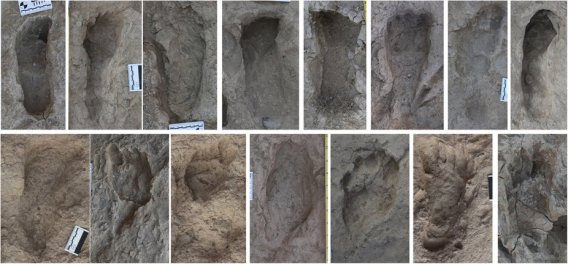
Ileret footprints. Photo: Hatala, K. G. et al. Footprints reveal direct evidence of group behavior and locomotion in Homo erectus. Sci. Rep. 6, 28766; doi: 10.1038/srep28766 (2016)
AFRICA (made by Homo sapiens)
Garden Route National Park, South Africa. 153 ka (thousand years). A footprint on the surface of a cemented sand dune (called an aeolianite), located west of the coastal town of Knysna on the Cape south coast. This is the oldest known footprint attributed to our species Homo sapiens. The two previously dated South African sites, Nahoon and Langebaan, had yielded ages of about 124 ka 117 ka respectively.
EUROPE
Happisburgh in Norfolk, UK. 850 ka. Assigned by many authors to Homo antecessor. Previously, the record for the oldest set of footprints in Britain was 7,500 years old, which pales in comparison to the Norfolk find.
Roccamonfina volcano, Italy. 350 ka. They were the oldest footprints in Europe before the Norfolk find. Called the «devil’s trails», they are preserved in volcanic ash atop the volcano. Assigned to Homo heildelbergensis.
Schöningen, Germany, 300 ka. Herds of elephants, rhinoceros and other species of herbivores congregated along the muddy shores of a paleolake during birch, pine and grass-rich woodland phases, leaving their footprints in two sites, Schöningen 13 I-Fs2 and Schöningen 13 II-2 Untere Berme. Among them, 3 potential hominin footprints are recorded at the latter site. 2 of the 3 human tracks are proposed to be of young individuals.
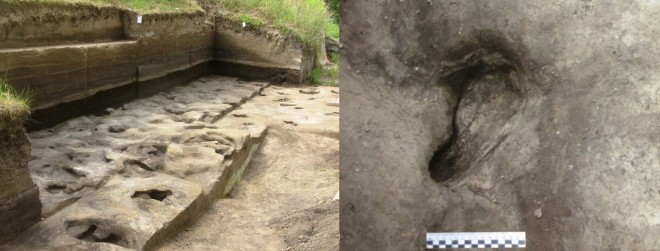
Fossil footprints (and potential hominin footprint) from the site Schöningen 13 II-2 Untere Berme. Credit: Senckenberg
EUROPE (made by Homo sapiens)
Theopetra cave, Greece. Four human footprints preserved in a reddish clay sediment, in association with various posterior hearths along the same layer which are dated to 46,327 BP.
Ciur-Izbuc Cave, Romania. 36,500 years. More than 400 footprints!
AMERICA
White Sands National Park, New Mexico, USA. A group of ~60 footprints radiocarbon-dated to 21,000-23,000 years old. Based on stature and walking speed, it appears that most of the footprints in this study come from teenagers and children. A subsequent independent study confirms the dating of 20-23 ka. However, further analysis which considers the hard water effect on Ruppia cirrhosa seeds (used for the dating) sets a younger age of 15,5-13,5 ka.
With 80,000 hectares, White Sands holds the world’s largest known collection of fossilized footprints from the Pleistocene, found around a dry lakebed with tracks from many fauna species. Another footprint track dated to 10,000-14,500 years (estimated overlap between megafauna extinction and known human presence in the area) is the longest trackway of fossil footprints in the world (at least 1,5 km). This was a very straight course: the individual did not deviate from it, and followed the trackway back again a few hours later.
Pilauco, Chile. Dated to 15,600 years, and associated with megafauna bones, plant material and unifacial lithic tools. This site might represent further evidence for a pre-Clovis South American colonization of northern Patagonia, as proposed for the nearby Monte Verde site. Monte Verde is a 12,5 ka open-air site with remains of a small settlement of 20-30 people where a small child also left a footprint.

Moreno K et al (2019) A late Pleistocene human footprint from the Pilauco archaeological site, northern Patagonia, Chile. PLoS ONE 14(4): e0213572. doi.org/10.1371/journal.pone.0213572
Calvert Island, British Columbia, Canada. 29 footprints along the shoreline of Calvert Island published in 2015. They are believed to be of a man, woman and child. At the base of the footprint track, pieces of preserved wood were radiocarbon dated to c. 13 ka.
Chihuahuan desert, Mexico. 10,550 years. 2 footprints, left and right. At the same site there are 11 other footprints dated to 7,250 years.
Lake Managua, Nicaragua. 6,000 years.
AUSTRALIA
Willandra Lakes, New South Wales. 20,000 years.
ASIA
Margalla Hills, Pakistan. 2 footprints made by Homo erectus 1 million years ago.
ASIA (made by Homo sapiens)
Nefud, Desert, Saudi Arabia. 112,000-121,000 years. 7 human footprints that represent the oldest evidence of Homo sapiens presence in the region.
Jeju Island, Korea. More than 100 human footprints and other thousands of horse, elephant, bird and deer fossil tracks left 50,000 years ago. Further studies suggest a more recent dating of between 19-25 ka.





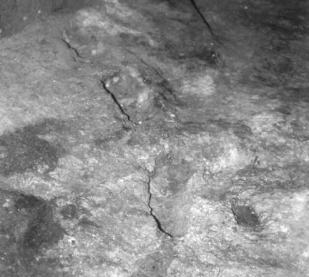


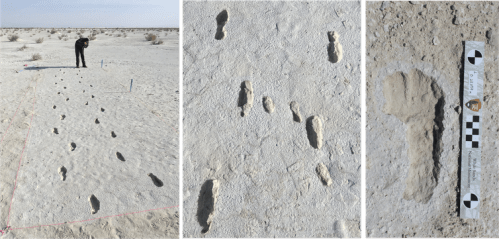






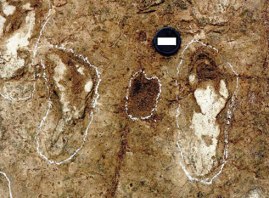
Pingback: Bitacoras.com
Pingback: Hoy Nutcracker Man cumple… 1 año! | Nutcracker Man
Pingback: Today Nutcracker Man turns… 1 year-old! | Nutcracker Man
Pingback: FOOTPRINTS | the heart thrills
Nice hyphenated adverb.
Me gustaMe gusta
Τhe Theopetra cave footprints in Thessaly, Greece are not mentined in this article…
https://www.academia.edu/3283600/THE_CAVE_OF_THEOPETRA_KALAMBAKA_RADIOCARBON_EVIDENCE_FOR_50_000_YEARS_OF_HUMAN_PRESENCE
Me gustaLe gusta a 1 persona
Now updated. Very interesting, thank you very much.
Me gustaMe gusta
The footprints discovered in Bolivia by researcher and explorer Kathy Wills are missing from this article. Bolivian Geologists place the sandstone rock stratum these footprints are found in is between 2 and 11 million years old. These footprints are found atop a mountain in northern Bolivia at apx. 15,000′ elevation (4,500 meters). Press release and more details are available at the link below.
http://www.xpeditions.tv/index.php?option=com_k2&view=item&layout=item&id=156&Itemid=661
Me gustaMe gusta
Pingback: January 2017 Newsletter | Huron Valley Chapter
What about the footprints found in the last few years on the beach in West Wales near the petrified forest? It looked like an adult and child.
Me gustaMe gusta
They are 3,000 to 4,000 years old, more recent than the rest of this list. Thanks for your comment.
Me gustaMe gusta
Ouah ! Magnifique et émouvant !
Me gustaLe gusta a 1 persona
Pingback: Best Reads from Lately – Stephen Graham Jones
What about the Trachilos footprints (5.7 mya, Crete in Europe)? Even though they were most likely not made by modern humans, I feel like they deserve some mention as the oldest bipedal footprints in the world. https://en.m.wikipedia.org/wiki/Trachilos_footprints
Me gustaMe gusta
Do the footprints in New Mexico now validate earlier claims of Pre-Clovis migrations from Polynesia and also possibly Over the Atlanta Ice from Solutreans – northern Spain?
Me gustaMe gusta